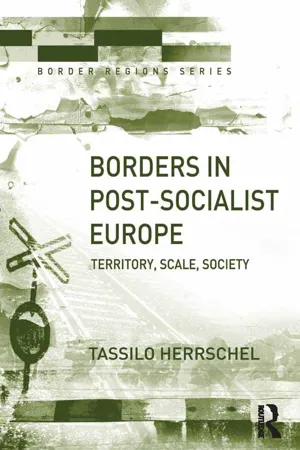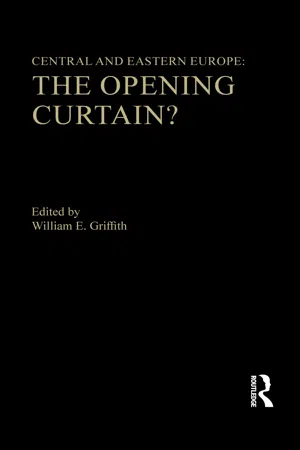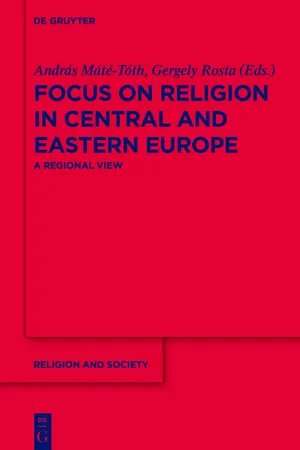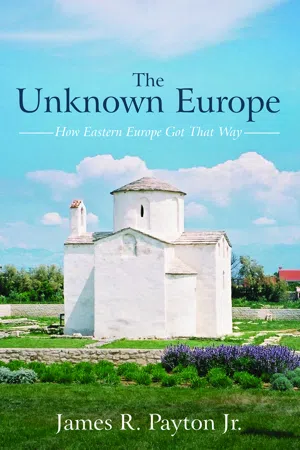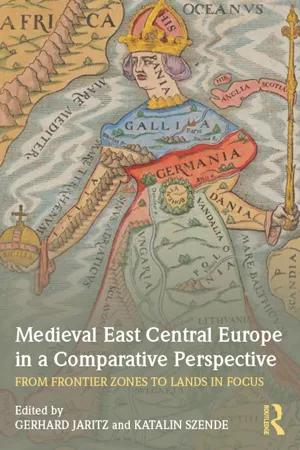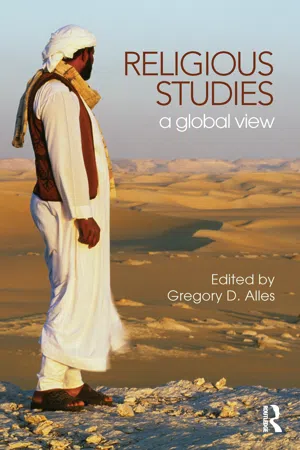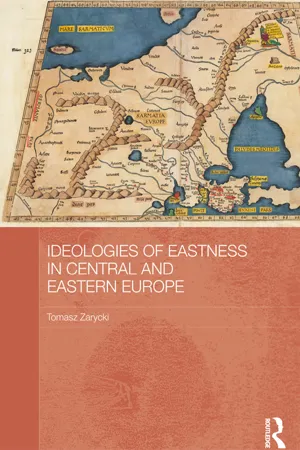History
Eastern Europe
Eastern Europe refers to the eastern part of the European continent, encompassing countries such as Poland, Hungary, Czech Republic, and others. Historically, this region has been influenced by various empires and has experienced significant political and cultural changes. It is known for its diverse ethnic groups, rich history, and complex geopolitical dynamics.
Written by Perlego with AI-assistance
Related key terms
7 Key excerpts on "Eastern Europe"
- eBook - ePub
Borders in Post-Socialist Europe
Territory, Scale, Society
- Tassilo Herrschel(Author)
- 2016(Publication Date)
- Routledge(Publisher)
vis-à-vis the ‘western’ part of the continent. Accordingly, Fowkes (1999) discusses the complexities of defining ‘Eastern Europe’ per se, in relation to ‘the West’, referring to particular historic, political or geographic rationales for the various groupings suggested in the literature. ‘Eastern Europe’ is often used with a negative undertone, especially in public discourse, referring to/implying underachievement, backwardness and a need for ‘catching up’ with the ‘advanced’ west as the ‘normal case’. Since joining the EU, ‘Eastern Europe’ has also become a byword for low cost production and cheap labour (Chirot, 1991). Historic legacies play an important part in the way in which the end of communism has generated differences and divisions within Eastern Europe: generally a lesser degree of urbanisation and industrialisation, manifesting a relative backwardness (and lesser economic capacity compared with its western counterpart. And there are the differences between the Ottoman influenced and the Roman Catholic and Christian Orthodox influenced parts of South-Eastern Europe (Balkans), and between most of the states in Eastern Europe that used to be part of the Soviet Union and those ‘merely’ under Soviet control but still separate nation-states. This produced not only different economic conditions, but also different forms of society and, in particular, experiences with democracy.In reality, there are many overlapping connotations of post-socialist European regionalisation: ‘Eastern’, ‘Central’, ‘South-eastern’, etc. None of these are clearly defined and are used by different authors with reference to varying geographic entities. As Fowkes (1999) points out, the Czechs, the Poles and the Hungarians, for instance, dislike being subsumed under ‘Eastern Europe’, and prefer the term Central Europe instead. One of the reasons is, of course, the signal sent out about the relative belonging to ‘Western’ and ‘Eastern’ Europe and the associated connotations of an ‘advanced West’, and ‘backward East’. In addition, there is the notion of the ‘East’ being closely associated with Russia/the Soviet Union, while the ‘west’ is associated with Western Europe and, by extension, the United States. Belonging to the latter group has been the main political and philosophical–ideological ambition of these countries since the end of communism. Their keenness to join the European Union and NATO underlines this attempt at geo-political repositioning. Against this background, Central Europe sounds closer to the ‘west’ than ‘Eastern Europe’. Fowkes (ibid.) suggests to “retain ‘Eastern Europe’ as an overarching geographical definition, and to use the term ‘East-central Europe’ to embrace Poland, Hungary, the Czech Republic and Slovakia, with the possible addition of the three ex-Soviet Baltic countries of Estonia, Latvia and Lithuania and the two northernmost ex-Yugoslav states of Slovenia and Croatia” (Fowkes, 1999, p. 2). - eBook - ePub
Central And Eastern Europe
The Opening Curtain?
- William E Griffith(Author)
- 2021(Publication Date)
- Routledge(Publisher)
2 Eastern Europe and the West in the Perspective of Time DOI: 10.4324/9780429033162-2Vojtech MastnyEastern Europe's place in the world is largely determined by the West's adversarial relationship with the Soviet Union, Because Moscow has seen the preservation of its hegemony in the region to be a vital interest, any infringement on that hegemony worsens East-West relations, Nevertheless, these relations, although still uncertain, now look brighter, and as a result the role of Eastern Europe is likely to change. Is the change to be for the worse or the better? Historically, the region has generated international instability. Two world wars originated there; so did the cold war. Although no catastrophes have occurred since, Eastern Europe has produced a sequence of crises, none accurately anticipated, that prompted the only hostile interventions the continent has experienced since 1945. Nor has this sequence necessarily ended.History can guide as well as deceive—nowhere more than in a region, like Eastern Europe, of exalted historical consciousness bred by a singularly traumatic past. What in the legacy of the past portends the future? How does Eastern Europe affect Western interests, and what, if anything, should be done about it? Any answer to these questions is inevitably subjective; however, the resulting uncertainty may be reduced by adopting a historical perspective.The Formative Traditions (to 1918)
A glance at the map of Europe shows that its eastern part is more land than sea oriented and more vulnerable than the western part to invasion. Yet apart from the great division between Western and Eastern Christianity— which is not coterminous with today's political division of the continent— for centuries Eastern Europe did not pose any special international problems. Not only were communications then severely limited, but for a long time few significant differences in the level of development distinguished Europe's East from West, and those that did often favored the East. The medieval kingdoms of Bulgaria, Serbia, Poland, and Bohemia, not to speak of the Byzantine Empire, matched or exceeded in achievement their western contemporaries. This relative homogeneity of Christian Europe did not last, however. For several reasons, its two parts began to diverge. - eBook - ePub
- András Máté-Tóth, Gergely Rosta, András Máté-Tóth, Gergely Rosta(Authors)
- 2016(Publication Date)
- De Gruyter(Publisher)
Emil Niederhauser is one of the Hungarian historians, in addition to Jenő Szűcs, whose work on the Eastern European region one has to consider foremost. Before the turn of the first millennium, East Central Europe was primarily characterized by the mixture of diverse ethnic groups living in the region and the lack of developed states. When approached from a historical perspective, the region is basically a frontier, a marginal region. If observed from the West, it is the frontier of the Frankish Empire; however, from East, the region is the Byzantine frontier. In the context of the Early Middle Ages, the region was the conflict zone of collisions of interests between the Western Church and the Eastern Church, by which collision we mean differences in worldviews, cultures, and economic and political forms of government, reaching up to the Enlightenment and in a certain way ostensible even in the present day, and not confined merely to differences in confessions of faith or in rites. Besides these Western and Eastern influences, the history of the region was affected by a third, a strong martial and cultural influence: the advance of the Ottomans and Turks. The influences of these three power blocks formed and defined the three subregions of the East Central European region, the features of which can be detected up to the present day: the Western, the Eastern, and the Balkan subregions. The centuries of the second millennium saw the changing and alternating influence of these powers, the traces of which can be felt with particular emphasis in these subregions even today (Niederhauser 2001). This tripartite influence explains the need for state and national sovereignty, determining the formation of all of the region’s societies depending on how much of this sovereignty they were able to procure in centuries past and/ or how long they were able to maintain it.A Hungarian research group, led by Endre Sashalmi and focusing on the region’s history of political constitution, took into account Niederhauser’s work, although disagreeing with many of his conclusions. The concept of the research and its main perspectives were based on the modified approaches of Ertmann and Finer, who in terms of government practices differentiated between substantive and procedural models. To the substantive model belong power-limiting factors related to the principles and the essence of power to which, besides tradition and laws, religion also belongs (Sashalmi 2007: 11 ff). According to the researchers, all forms of government classified according to different principles can be found in both Western and Eastern Europe, hence erasing the differentiation between East and West. However, there are some formations that can be seen merely as features of the subregions of the Eastern European region in its broadest sense. This again brings us to the ambivalence around the topic of regional peculiarity. Are there or are there not specific features distinguishing the regions? The comparative study spanning the historical period between 1000 and 1800 concludes that, based on the logic of succession of political power within Eastern Europe, it is by the fifteenth century that the government models of the Rus and the three Christian kingdoms diverge. Therefore, it is politico-historically justified to distinguish the greater region East Central Europe from Eastern Europe (Sashalmi 2007b: 398 ff). By the eighteenth century this image of the region had become even more nuanced (Sashalmi 2007b: 401); however, there is no present need to elaborate on it. - eBook - ePub
The Unknown Europe
How Eastern Europe Got That Way
- James R. Payton(Author)
- 2021(Publication Date)
- Cascade Books(Publisher)
89 have shown how inadequate were the Communist orientation, on the one hand, and western historiography on Eastern Europe, on the other, for understanding either the past or the present of Eastern Europe. Unless the pattern under criticism changes drastically, that historiography will proffer little help for understanding what will likely transpire in the future, either.The temporal imbalance becomes graphic if one considers the percentage of the history of Eastern Europe actually treated in that historiography. The geographic region has been peopled by its current inhabitants since the Slavic invasions of the sixth through the eighth centuries.58 Consequently, the history of these various peoples can be traced back to that period. If, to adopt a conservative point to begin, one takes 700 AD as the starting point for Eastern European history, the potential timespan for such a treatment would be a little over 1,300 years. The period of Communist domination began, at the earliest, in 1945 —although for several of the countries of Eastern Europe, effective domination of government by the Communists did not occur until somewhat later.59 Communist suzerainty ended in 1989 ; thus, the Communist period of Eastern European history, on which historical scholarship has focused its treatments, was only forty-four years long. This means, consequently, that these “histories” of Eastern Europe have zeroed in on 3 .38 percent of the actual history of Eastern Europe.Were one to adopt that approach with the history of the United States of America, the results would be ridiculed. If 1607 (the founding of the Jamestown colony in Virginia) can be accepted as a fair date to begin the history of what would eventually be the U.S.A., then there are (as of 2022 ) 415 years of that history. A history that focused on the last 3 .38 percent of those four hundred years would result in a study of only the last fourteen years - eBook - ePub
Medieval East Central Europe in a Comparative Perspective
From Frontier Zones to Lands in Focus
- Gerhard Jaritz, Katalin Szende(Authors)
- 2016(Publication Date)
- Routledge(Publisher)
12For many years, my Department of Medieval History at the Institute of Slavic Studies RAS pursued research on several features of Central Europe in comparison with the areas to the west, east and south-east of it. A major step in establishing an exchange of ideas within the region was the launch of a series of conferences under the title Slaviane i ikh sosedi (Slavs and their neighbours). These annual meetings are held in memory of Vladimir D. Koroliuk (1921–1981), long-time Head of the Department of Medieval History at the Institute and author of important studies on Polish history and early medieval Slavs and German–Slav relations.13 While the point of departure remained the traditional concept of ‘Slavs’, the aim was to place them into the context of the wider region. At the 27 conferences held so far, subjects discussed in a comparative context included influences and relations of the countries of the region to each other, Catholicism and Orthodoxy, the Ottoman Empire, imperial ideology, Slavs and Germans, warfare, travel, migrations, Christianization – always in the context of Central and SouthEastern Europe. There is no doubt that these meetings enhanced the comparative study of the region among members of the institute and other scholars. Besides these annual meetings, the department produced many volumes of collected studies focused on important issues such as ethnic consciousness in the region, formation of feudal society, social-political thought, Christianization of the region and so on.14 I believe that this regional approach was important in inspiring Boris N. Floria, the head of the medieval section of the Institute, known for his studies on early Czech, Polish and Rus’ history, to present his ideas about ‘Central Europe in Medieval Europe’ at the 1995 conference.15 - eBook - ePub
Religious Studies
A Global View
- Gregory D. Alles, Gregory D. Alles(Authors)
- 2010(Publication Date)
- Routledge(Publisher)
et al ., 1985), and there is also virtually no study of religious studies in Eastern Europe comparable to studies of the field in Western Europe, North America, Japan, South Africa, and Australia by prominent scholars of religion aware of and interested in the history of their field. Curiously, many Eastern European scholars interested in the local background of their discipline can recount better the history of the field in Western than in Eastern Europe. The following preliminary sketch, in many respects unprecedented, is of necessity more modest than already classic or recent research, such as Mircea Eliade (1963), Jacques Waardenburg (1974), Eric J. Sharpe (1986), Hans G. Kippenberg (1997/2002), Arie L. Molendijk and Peter Pels, eds (1998), Gregory D. Alles (2005), and Giovanni Casadio (2005). It is, I hope, only a beginning. But it does try to go beyond the contemporary scholarly preoccupation of simply discussing ‘The Academic Study of Religion during the Cold War’ (Doležalová, Martin, and Papoušek [eds] 2001), followed by an attempt to discern the hottest academic pursuits now that the Berlin wall has fallen and the Iron Curtain has progressively dissolved.For our purposes, Eastern Europe includes one country that joined the European Union in 1981—Greece—several that joined the EU in 2004 and 2007—Bulgaria, the Czech Republic, Estonia, Hungary, Latvia, Lithuania, Poland, Romania, and Slovakia—and others that are not EU members—Albania, Bosnia-Herzegovina, Croatia, Macedonia, Montenegro, Serbia, Slovenia, Belarus, Moldova, Ukraine, and at least a part of Russia. This political multiplicity is mirrored in scholarship. There is virtually no permanent communication between all, or even a significant majority, of scholars in the region. This is perhaps a result of the kaleidoscope of languages, which mixes a large number of Slavic languages together with Modern Greek and Romanian. Another cause is the insufficiently secularized culture of the Orthodox communities that constitute a majority in the region. (This cause is insufficiently studied.) The political history of the region is also a contributing factor. Two and a half—and even one and a half—centuries ago Eastern Europe was dominated by the Habsburg, Russian, and Ottoman empires. In the nineteenth and early twentieth centuries new or reinvigorated nation-states often found in the category ‘religion’ fuel for identity struggles rather than an invitation to calm, rational, erudite investigation. Historians have repeatedly pointed out that periods of free cultural development have been rare in this region. By contrast, regression and subsequent restratification have recurred vigorously, and it has been common for methods from various scholarly epochs to exist side by side. That mixture characterizes religious studies in Eastern Europe today. In the very same cultural location, a Frazerian approach might coexist with fashionable, recently imported postmodern methodologies, and academic discourse about religion(s) in one and the same country may simultaneously include both an antiquated ‘hierarchy’ of religions with false claims to objectivity, mainly within the faculties of Orthodox theology, and positivist scholarship that treats ‘religion’, as it treats every other epistemological object, very unsystematically. Until now no Central or Eastern European scholar has investigated this diversity, and it is rare to meet in a single publication references to, for example, Czech, Polish, Greek, and Russian research, except for some Eastern European topics, which are in any case rather rarely discussed. - Tomasz Zarycki(Author)
- 2014(Publication Date)
- Routledge(Publisher)
I will not try to assess the exact position of specific countries of the region and, in particular, to establish which of them firmly belong to the “semi-peripheral” zone, and which are closer to the more distant peripheral region. In some contexts, such distinctions may, of course, be relevant. In this book however, references to such a detailed model of the world-system do not seem indispensable. Here, I won’t attempt to provide an overview of the geopolitical history of Central and Eastern Europe either. Later in the book, a short summary of the evolution of Eastern Poland’s position will be provided as a case study, which can illustrate the approach adopted in this book. Here let me only remind the reader that the region’s peripheral location in relation to the Western European core has a clearly historical genesis. This has been made especially clear in the classic Wallerstein study. In his seminal “Modern World-System”, Wallerstein estimated the roots of dependence of Central Europe, in particular of Poland, as going back to at least the seventeenth century (Wallerstein, 1974b). Another specific historical process was the emergence, in the eighteenth century, of a relatively strong peripheral empire, namely Russia. Russia consequently became a secondary (in relation to the Western core), but, at times, a powerful second pole of power in the region. For the entire nineteenth century, the Russian Empire controlled much of Central Europe, while its remaining parts were under the control of the Austrian and Prussian empires. After transforming itself into the Soviet Union after the First World War, by 1945 Russia managed to take under its control a considerable part of the continent, in particular, the entire area of Central and Eastern Europe. At the same time, one could argue that the Soviet Union remained in many aspects dependent on the core of the world system and, in effect, peripheral to it in different aspects. Therefore, the region of Central Europe remained constantly under dual dependence of changing proportions. Finally, about 1990, the Russian/Soviet grip over Central Europe weakened and eventually waned, while a major part of the region returned under the direct influence of the Western core. The process of changing the balance of forces over the region, in particular, the cycle from the moment of expansion of the Soviet Block into Central Europe in 1945 to its demise in 1989, was labeled by Iván Berend a “detour from periphery to the periphery” (Berend, 1996). József Böröcz in turn noted that the withdrawal of the Soviet Union from Central Europe in 1989 produced what he called a “property vacuum”, soon filled by Western capital (Böröcz, 1992).However, the dynamics of these processes was quite different in specific parts of Central and Eastern Europe. While the entire region of Central and Eastern Europe can be seen as currently strongly dependent on the Western core, the nature of this dependence is different in its different parts. In this book, I will divide the region into three basic zones in order to make the discussion about the basis mechanisms of its dependence more clear. The three regions I will distinguish, differ by their degree and nature of Western domination, but also by their construction of political scenes, which translates Western domination and Western discourses, including critical such discourses, in very different ways. Let me characterize them in the following way:The first zone is the so-called Central Europe, consisting of the former “socialist” or “communist” states remaining under Soviet control until 1989. The zone is currently an internal periphery of the European Union, and the domination of the Western core is most clear in that region. The political scenes in the countries of the region evolved, as it will be discussed with more detail below, from oriented towards the former Soviet domination in the direction of being oriented towards Western domination. Hungary and Poland seem the most illustrative cases for this group of states, where cleavages pitting anti- and post-communists have been replaced by cleavages pitting liberal Euro-enthusiasts and conservative Euro-skeptics.The second zone
Index pages curate the most relevant extracts from our library of academic textbooks. They’ve been created using an in-house natural language model (NLM), each adding context and meaning to key research topics.
